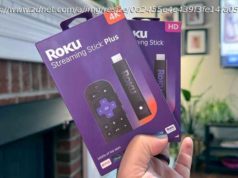Amazon Fire TV Cube goes far beyond being an Echo/Fire TV stick hybrid. Thanks to HDMI CEC control, an IR blaster, and a new user interface, the Fire TV Cube can take even the most complicated entertainment system and simplify it so just about anyone can use it.
When Amazon officially announced its new Fire TV Cube, the device was oversimplified in headlines as a Fire TV stick and Echo speaker crammed together into a glossy black box. The fact that the Fire TV Cube would be able to control a TV was almost a footnote, and descriptions of those capabilities were often limited to turning the TV on and off and its volume up and down. Turns out, the Fire TV Cube is more advanced than that. Way more.
The Fire TV Cube puts Amazon’s Alexa voice assistant in a Fire TV device for the first time, but thanks to HDMI CEC and an IR blaster, the Fire TV Cube also makes you master of your entire entertainment system – even if said entertainment system is complicated – using the power of your voice. On paper it sounds great. In practice, it’s far better than we expected.
You won’t be throwing your remote controls in a garbage bin and saying goodbye forever, but the Fire TV Cube will allow you to stuff those button-laden wands in a drawer and forget about them for days at a time.
That’s only part of the reason the Amazon Fire TV Cube is our new favorite streaming box – and this coming from a die-hard Roku fan .
Amazon smartly packages the Fire TV Cube in entirely recyclable packaging with no fluff involved. In the box, you’ll find the Cube wrapped in plastic and further protected by plastic film. If you end up tossing the plastic away before reading the setup alert printed on it, take note that you’ll want to set the Fire TV Cube up in a visible place (don’t tuck it away behind a cabinet door or drop it behind a wall-mounted TV), and at least one foot away from any speakers so that the microphones built into the top of the unit can easily distinguish voice commands from TV programming or music.
In the box with the Cube you’ll find an Ethernet adapter (if you’ve got a hardline internet connection best to use it, but Wi-Fi is built in), power cord, an extendable IR Blaser with a cable of generous length, and a Fire TV voice remote with batteries. Yes, the Cube, which touts voice commands as its primary feature, still benefits from having a remote from time to time. Plus, not everyone is into using voice for everything – sometimes you just want a clicker to get the job done.
Amazon does a great job making Fire TV Cube setup as intuitive and easy as possible. If you order the Fire TV Cube directly from Amazon using your Amazon account, for instance, it should arrive already signed into your account. Otherwise, the Cube’s setup wizard will first ask for Wi-Fi sign-in credentials (if you don’t use Ethernet to connect to your router), then get you to input your Amazon account information. Following that, you’ll be prompted to add any of the super-popular apps Amazon thinks you might want, and while those apps download in the background, the Fire TV Cube gets to work learning about your entertainment system.
If all you’ve got is a TV, then this part of the process will go quickly. The Fire TV Cube can recognize many newer TVs automatically and will just verify it can successfully control power, volume, and mute functions before running you through a video tutorial.
If you use a soundbar or A/V receiver, things get a little bit trickier. Here, Amazon assumes you will be plugging the Fire TV Cube into an A/V receiver directly and will run a bunch of tests to ensure it is able to turn the TV and receiver on and off, control volume, etc. If, however, you like to connect all your gear directly to a TV and then run an audio signal to your receiver using HDMI ARC, you’ll have to let the setup guide do its thing, then make a few changes in the settings menu later. The same goes for a soundbar.
What Amazon doesn’t seem to prompt you to do is to go into all applicable devices and turn on HDMI CEC (Consumer Electronics Control). We had to turn HDMI CEC and HDMI ARC on for our LG E8 OLED TV and Anthem MRX-1120 A/V receiver to ensure all went smoothly. Some TVs (many from Samsung, for example) come with CEC enabled automatically, but others don’t, so be sure to dig into your settings menu to be sure.
From there, it’s up to you to add any other devices you want the Fire TV Cube to account for. We added a Blu-ray player and a PlayStation 4 console, but if we had a cable box or satellite receiver, you can bet we’d have added those since controlling cable/sat boxes and accessing live TV is one of the things the Fire TV Cube does best.
We’re going to go out on a limb and presume you’re familiar with Fire TV and Amazon Alexa basics, just so we can dig right into what makes the Fire TV Cube special (there’s a lot). In case you need a refresher, though, here’s our review of the 3 rd Gen Fire TV box and the latest Amazon Echo speaker to get you up to speed in a jiffy.
Describing the Fire TV Cube as an Echo and Fire TV smooshed together is as inaccurate as it is reductive. The Fire TV Cube can do many things a Fire TV operated by an Echo speaker can’t outside of hardware control.
For instance, you can tell Alexa to tune into ESPN on Xfinity, Dish Network, or DirecTV and it will change the TV’s input to whichever cable/satellite box is connected, then change the channel on the cable box to ESPN. You can also specify the channel number you want. But what we liked best was telling Alexa to tune to a specific TV show and have her simply launch the TV show on the right channel.
If you’re a cord-cutter, we have great news: Amazon Fire TV Cube works with PlayStation Vue and Hulu Live TV right out of the box, and support for other live streaming TV services is promised soon.
One of the most notable changes to the Fire TV platform that we noticed while testing the Cube was how Amazon now puts all apps on a level playing field, both on its home screen and through search. It used to be that if you searched for House of Cards, Amazon would serve up its own Prime Video paid option over the obviously free availability on Netflix. With the Fire TV Cube, if you ask it to play House of Cards, Ozark, Handmaid’s Tale, or any other number of original shows from competing services, it will go straight to the correct app and (provided you’ve got a subscription) start playing the show. If you ask to watch a show that isn’t available for free from one of your subscribed services, the Fire TV Cube will show you what your options are, even if what you want isn’t available on Amazon’s own Prime Video service.
This app-agnostic approach plays out on the Fire TV Cube’s home screen as well. We noticed a “Netflix recommends,” and “Vudu recommends” strip loaded with shows we recently watched and other options like those shows we’ve watched in the past. It wasn’t even necessary to go into the Netflix app to restart Ozark — it was right there on the Fire TV Cube’s home menu; that feels like a big leap forward for Amazon.
Additional streaming guides
Best shows on Netflix
Best Movies on Netflix
Best movies on Hulu
Best movies on Amazon Prime
Best movies on HBO
Of course, if you want to jump away from the Fire TV Cube’s onboard streaming options, it will help you get to your Blu-ray player, Xbox, PlayStation, and even Roku device.






